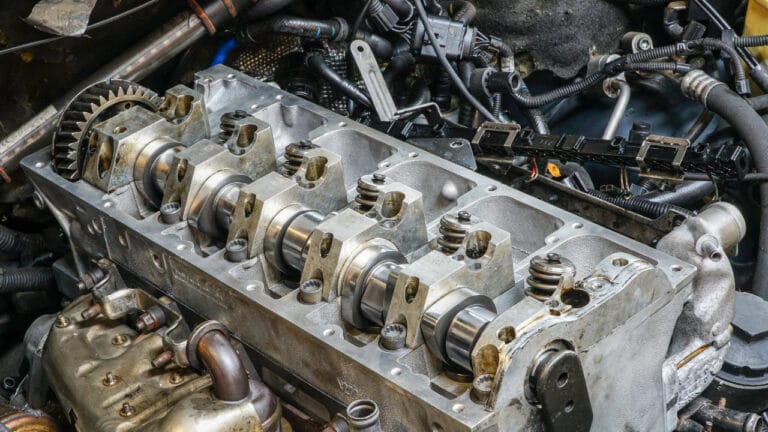How to Turn Over (Crank) Engine Without Starting It?
Among all the techniques for diagnosing your engine, turning an engine over (without starting) is the most straightforward one. You’ll need this technique, especially if you live in a cold region.
So, how to turn over an engine without starting it? Simply put the key in the ignition and turn it to START without pushing the gas pedal. Let the starter motor spin the engine for 3 to 5 seconds. You can also use a remote car starter to turn the engine over from outside the car.
Another way is to connect a jumper cable from the positive battery terminal to the starter solenoid terminal. Now, you’ll need a full idea on this before you actually do turn over your engine. Luckily, we’ve covered everything you need to know right below.
How to Turn Over an Engine Without Starting It?
Let’s look at in-depth methods for turning over an engine without starting in the proper way:

Method 1: Using the Ignition Key
The simplest way to crank (turn over an engine) without starting is by turning the key to the START position without pushing the accelerator. This engages the starter motor. In turn, the motor turns over the engine while disabling the ignition and fuel systems.
- Insert the key and turn to the RUN position (not START).
- Do not press the accelerator.
- Now, turn the key fully to the START position to engage the starter only.
- After 3-5 seconds, release the key to the OFF position.
Now you have finished turning over the engine without actually starting it.
Method 2: Using a Remote Starter
On many modern vehicles, a remote starter can be used to crank the engine without starting. For example, Mazda cars have it.
Like the previously mentioned method, this engages the starter while the ignition remains disabled. It offers the convenience of cranking remotely without being in the vehicle.
- Activate the remote start system (but do not start)
- Push the START button on the remote fob to turn over the engine
- After 3-5 seconds prime, press the STOP button.
This provides remote pre-lube cranking for cold winter starts and warm-up before driving. It can also test the starting system function remotely.
Method 3: Using a Starter Relay
The starter relay connects the battery power to the starter motor when you turn the key to start the engine. We can use it to manually engage the starter unit without turning the key.
Here are the steps:
- Locate the starter relay in the fuse and relay box, usually under the hood. It will be labeled “starter” or have a picture of a starter on it.
- Find the coil terminal on the relay, typically labeled “85”. This small terminal activates the relay when powered.
- Use a jumper wire to send the 12V to the coil terminal. This will magnetize the coil and close the relay contacts.
- With the relay now closed, it will connect the large battery power terminal on the relay to the starter motor terminal. This engages the starter.
- Let the engine crank for 3-5 seconds to prime the oil system. No ignition or fuel will be activated because we are just using the relay.
- Remove the jumper wire from the coil terminal to stop the cranking.
Here’s a video to help you understand the whole process:
Method 4: Using a Jumper Cable
A jumper cable can directly power the car’s starter to turn over the engine as an isolation test.
Connecting the battery’s positive terminal to the starter’s “SOLENOID S” terminal engages the drivetrain. This turns over the engine without any other system’s actuation.
- Attach one jumper cable to the positive terminal
- Attach the other end to the starter Solenoid S terminal
- The engine’s cranking (turning over) process will start
- Remove the jumper cable quickly after cranking
How Long Can I Crank an Engine Without Starting It?
According to a Washington Post report, the duration of cranking (turning over) your car’s engine should not exceed 30 seconds. When cranking without starting, it’s important to limit continuous cranking time to avoid heat damage or premature wear.

Here are our tips on the length of engine cranking (turning over):
- For cars with a pre-lube system for cold start, limit cranking to 3-5 seconds. This will prime the oil system without over-cranking.
- When testing, limit continuous cranking to 10-15 seconds maximum. Allow the starter system to cool between tests.
- Total cranking time should not exceed 30 seconds during a single troubleshooting session.
- If the engine does not start within 10-15 seconds on warm restart, discontinue cranking to avoid damage.
Troubleshooting Tips for Turning Over Engines Without Starting
When the engine turning over technique is not working, methodically crank the engine without starting to narrow down the problem:
1. If the Engine Doesn’t Crank at All:
- Check battery voltage and connections. Load test battery. Charge or replace as needed.
- Check the transmission range sensor and shift interlock. Make sure the correct park/neutral position.
- Check the starter fuse, relay, and wiring harness connections. Tighten or replace as needed.
- Remove and bench-test the starter motor. Repair or rebuild as needed.
- Inspect the flywheel ring gear for damage. Replace/machine flywheel if damaged teeth.
- Make sure the starter mounting bolts are tight. Realign and shim starter as needed.
2. If the Engine Cranks Slowly:
- Your battery is weak, dying, or has a bad connection(s). Inspect, charge, load test, or replace.
- Corroded or loose battery cables and terminal contacts. Clean and tighten connections.
- The starter solenoid has dirty contacts or is not fully engaging. Clean and test solenoid.
- Starter motor brushes are worn out. Inspect and replace brushes as needed.
- Low engine compression makes starting more difficult. Diagnose and fix compression issues.
- Oil is very thick in extremely cold conditions. Allow more cranking time as needed.
How to Turn Over an Engine With a Dead Battery?
According to the insights from J. D. Power, a dead battery lacks sufficient charge to crank (turn over) the starter motor. So, here are our tips for cranking with a dead battery:

- Step 1: Connect a jump starter pack or external battery charger to provide cranking power. Charge the battery after starting.
- Step 2: Bump start or push start the vehicle with a manual transmission by releasing the clutch with the vehicle moving. This does not require a battery.
- Step 3: Connect cables to another vehicle and jump-start the engine. Let it charge the battery after starting by leaving jumper cables connected to the donor vehicle running.
- Step 4: If the battery is totally dead, remove and bench charge it overnight before reinstalling. A charger may help recover a deeply discharged battery.
- Step 5: Replace the old battery as needed if it is no longer able to hold a proper charge. A new battery ensures reliable cold starting.
The key is providing an alternative strong 12-14 volt power source when the battery lacks cranking power.
How to Turn Over an Engine With a Bad Fuel Pump?
Your engine might not be cranking (turning over) because of a bad fuel pump. However, it can still be cranked. Here’s how:
- Step 1: Remove the fuel pump fuse or relay to disable the pump during cranking. This eliminates any false starts from intermittent pump operation.
- Step 2: Crank the engine for 10-15 seconds without fuel to check for ignition spark and compression. This isolates engine issues from fuel delivery problems.
- Step 3: With the fuel pump disabled, spray some starting fluid into the engine’s manifold while cranking. Simultaneously, check for ignition spark. This may allow momentary combustion.
- Step 4: Inspect the fuel pump, filter, pressure regulator, wiring harness, and relays for faults. Repair, replace, or rebuild components as needed.
- Step 5: Once the fuel pump is repaired, reinstall the fuse/relay and confirm that the engine starts before further diagnosis.
FAQs
Check out some common queries that might pop up in your mind:
1. Can I turn over an engine without oil?
It is never recommended to crank an engine without proper oil level and pressure. Just 3-5 seconds of dry cranking can severely damage the engine.
2. Can I turn over an engine without spark plugs?
It is possible to bump a starter for a few revolutions without a spark plug removed. However, it may allow debris into cylinders or cause engine damage.
3. Is it bad to turn over an engine without starting it?
Turning over an engine without starting is generally safe. No harm should occur as long as total cranking is kept under 30 seconds at a time.
Conclusion
To wrap it all up, cranking the engine without starting is an important technique for priming the oil system or diagnosing no-start issues. To turn over (crank) your engine, simply insert the key and turn it to the START position without pressing the accelerator. Let it turn over for 3-5 seconds to prime the oil system.
You can also use a remote starter to crank the engine remotely. Additionally, you can activate the starter relay or use a jumper cable from the battery to the starter solenoid to engage the starter drive.






